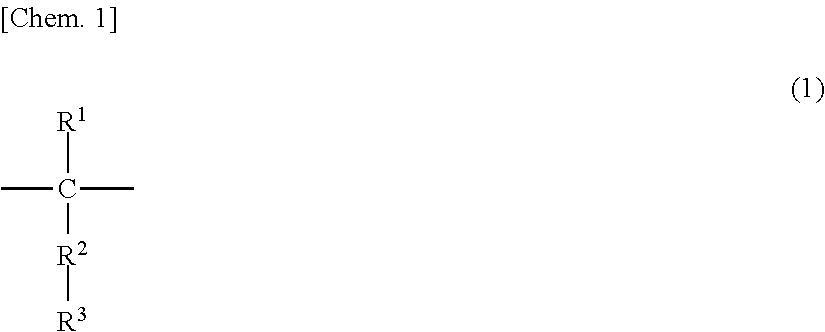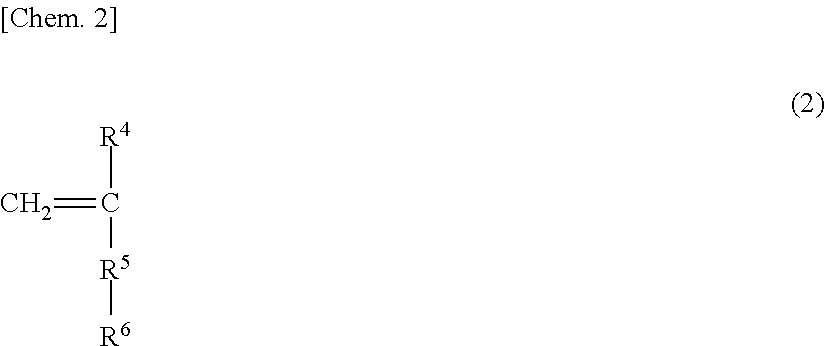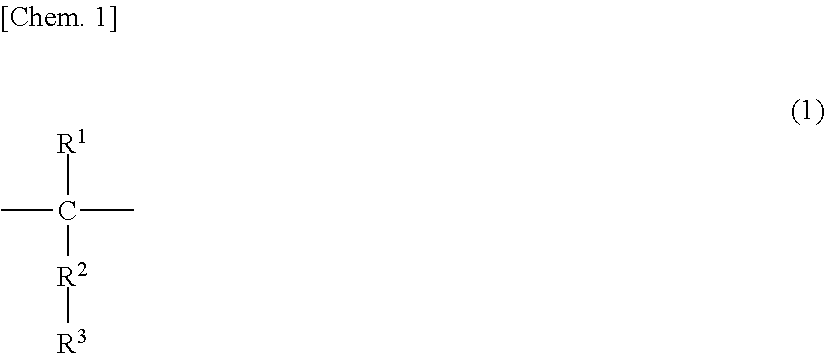Polyvinyl acetal microparticles for water-based dispersion
- Summary
- Abstract
- Description
- Claims
- Application Information
AI Technical Summary
Benefits of technology
Problems solved by technology
Method used
Image
Examples
example 1
[0108]Into a reactor equipped with a thermometer, a stirrer, a nitrogen introduction pipe, and a condenser tube, 25 parts by weight of a polyvinyl acetal resin (degree of polymerization: 800, degree of butyralization: 65.0 mol %, hydroxy group content: 33.8 mol %, acetyl group content: 1.2 mol %), 1 part by weight of sodium 2-sulfoethyl methacrylate and 100 parts by weight of dimethyl sulfoxide were charged, and the polyvinylbutyral and sodium 2-sulfoethyl methacrylate were dissolved in the mixture with stirring. Next, the reactor was flushed with nitrogen gas for 30 minutes to purge the reactor with nitrogen, and the contents of the reactor were heated to 85° C. with stirring. After 30 minutes, 0.5 parts by weight of t-butylperoxy-2-ethylhexanoate, which serves as a polymerization initiator, was diluted with 5 parts by weight of dimethyl sulfoxide, and the resulting polymerization initiator solution was added dropwise to the reactor over 3 hours. Then, the mixture was further react...
example 2
[0110]Into a reactor equipped with a thermometer, a stirrer, a nitrogen introduction pipe, and a condenser tube, 25 parts by weight of a polyvinyl acetal resin (degree of polymerization: 800, degree of butyralization: 65.0 mol %, hydroxy group content: 33.8 mol %, acetyl group content: 1.2 mol %), 1 part by weight of methacrylic acid and 100 parts by weight of dimethyl sulfoxide were charged, and the polyvinylbutyral was dissolved in the mixture with stirring. Next, the reactor was flushed with nitrogen gas for 30 minutes to purge the reactor with nitrogen, and the contents of the reactor were heated to 85° C. with stirring. After 30 minutes, 0.5 parts by weight of t-butylperoxy-2-ethylhexanoate, which serves as a polymerization initiator, was diluted with 5 parts by weight of dimethyl sulfoxide, and the resulting polymerization initiator solution was added dropwise to the reactor over 3 hours. Then, the mixture was further reacted at 85° C. for 3 hours, and the reaction solution wa...
example 3
[0112]Into a reactor equipped with a thermometer, a stirrer, a nitrogen introduction pipe, and a condenser tube, 25 parts by weight of a polyvinyl acetal resin (degree of polymerization: 800, degree of butyralization: 65.0 mol %, hydroxy group content: 33.8 mol %, acetyl group content: 1.2 mol %), 1 part by weight of dimethylaminoethyl methacrylate, and 100 parts by weight of dimethyl sulfoxide were charged, and the polyvinylbutyral was dissolved in the mixture with stirring. Next, the reactor was flushed with nitrogen gas for 30 minutes to purge the reactor with nitrogen, and the contents of the reactor were heated to 85° C. with stirring. After 30 minutes, 0.5 parts by weight of t-butylperoxy-2-ethylhexanoate, which serves as a polymerization initiator, was diluted with 5 parts by weight of dimethyl sulfoxide, and the resulting polymerization initiator solution was added dropwise to the reactor over 3 hours. Then, the mixture was further reacted at 85° C. for 3 hours, and the reac...
PUM
| Property | Measurement | Unit |
|---|---|---|
| Fraction | aaaaa | aaaaa |
| Molality | aaaaa | aaaaa |
| Particle size distribution | aaaaa | aaaaa |
Abstract
Description
Claims
Application Information
 Login to View More
Login to View More - R&D
- Intellectual Property
- Life Sciences
- Materials
- Tech Scout
- Unparalleled Data Quality
- Higher Quality Content
- 60% Fewer Hallucinations
Browse by: Latest US Patents, China's latest patents, Technical Efficacy Thesaurus, Application Domain, Technology Topic, Popular Technical Reports.
© 2025 PatSnap. All rights reserved.Legal|Privacy policy|Modern Slavery Act Transparency Statement|Sitemap|About US| Contact US: help@patsnap.com



